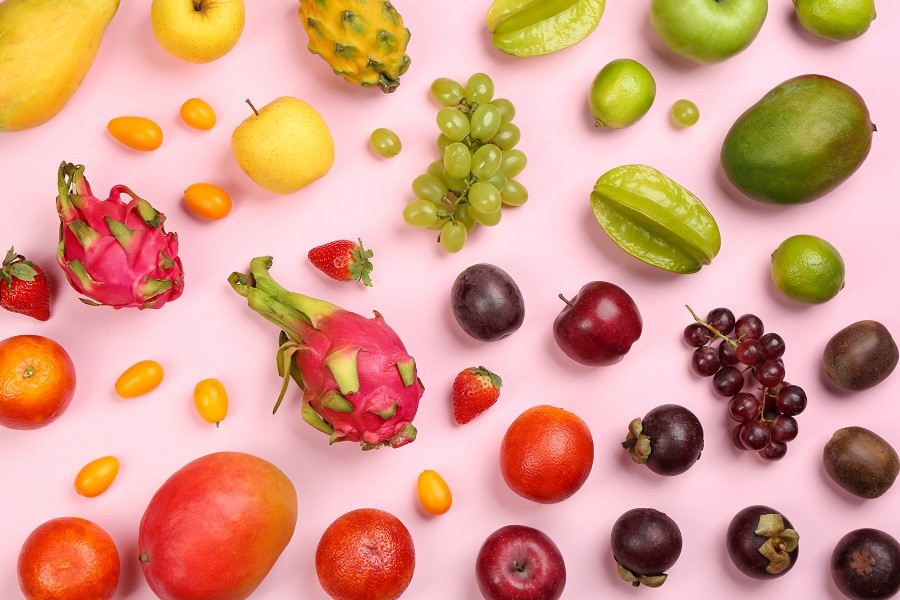Fruit and diabetes: is there any fruit recommended?

Fruit is integral to a healthy, balanced diet [1,2,3]. If you are living with diabetes, you can eat any fruit. However, it may be useful to consider their carbohydrate content and their effect on blood glucose levels [2,4,5]. Portion control is key.
Fruit: is it good or bad?
Low in calories and rich in vitamins, fibre, minerals, and antioxidants, fruit contains numerous nutrients that benefit health [1,3].
According to several clinical studies, a plant-based diet helps to prevent heart disease and obesity and to reduce risks of high blood pressure and bad cholesterol [3].
For people living with diabetes, fruit contains many health benefits. However, fruit options and the timing of eating fruit needs to be individualised. [2,3,6].
Which fruit should I eat and in what quantities?
The composition of your meals, and specifically the amount of fruit your dietitians as part of your diabetes care team advises you to eat every day, will vary depending on your type of diabetes, medication and your medical profile [2]. However, most public health guidelines recommend two portions of fruit per day [7].
What is considered to be a portion of fruit?
For the Food Standards Agency (FSA), a portion of fruit weighs 80 grams. This is equivalent to a handful of grapes, cherries or red berries, an apple, a small banana, a pear, an orange other similar-sized fruit. A 150ml glass of fruit juice counts as one portion, but for diabetes, eating your fruit’s recommended rather than drinking it [1]. ome might choose to use fruit juice as their choice of hypo treatment.
When choosing a particular fruit, it is a good idea to consider its glycaemic index (GI), which reflects a food's ability to raise blood glucose levels [2,4]. Studies have shown that low GI fruit can help to manage diabetes by not unduly raising blood glucose levels after a meal, but this will depend on the overall glycaemic load (the overall carbohydrate intake at that meal) at the particular meal[2,3,5].
If you have type 1 diabetes or type 2 diabetes treated with insulin, it is advisable to adjust your insulin doses according to the quantity and type of fruit you eat. [2].
Fruit Juice
Compared to whole fruit (either fresh, frozen or dried), fruit juice is generally higher in sugar and lower in fibre (With hardly containing any fibre) and can raise blood glucose levels quickly [1,3,5]. Also, if you are trying to lose weight or maintain a healthy weight, remember that whole fruit is more filling than its juice [1,6].

What are the fruits with a low GI?
The fruits with the lowest GIs are:
- apples;
- pears;
- oranges;
- peaches;
- apricots;
- plums;
- cherries;
- red berries (blackberries, blueberries, raspberries, strawberries) [2,4,8].
What are the fruits with a high GI?
While most fruits have a low GI (55 or less) [8], we recommend discussing the best fruit option and portion with your diabetes care team.
Sources
- Slavin JL, Lloyd B. Health benefits of fruits and vegetables. Adv Nutr. 2012;3(4):506-516. Published 2012 Jul 1. doi:10.3945/an.112.002154
- Canadian Diabetes Association Clinical Practice Guidelines Expert Committee. Nutrition Therapy. P.D. Dworatzek et al. / Can J Diabetes 37 (2013) S45eS55
- Mark L Dreher. Whole Fruits and Fruit Fiber Emerging Health Effects. Nutrients. 2018 Nov 28;10(12):1833. doi: 10.3390/nu10121833.
- M T Guevarra, L N Panlasigui. Blood glucose responses of diabetes mellitus type II patients to some local fruits. Asia Pac J Clin Nutr. 2000 Dec;9(4):303-8. doi: 10.1046/j.1440-6047.2000.00159.x.
- D J A Jenkins, K Srichaikul, C W C Kendall, J L Sievenpiper, S Abdulnour, A Mirrahimi, C Meneses, S Nishi, X He, S Lee, Y T So, A Esfahani, S Mitchell, T L Parker, E Vidgen, R G Josse, L A Leiter. The relation of low glycaemic index fruit consumption to glycaemic control and risk factors for coronary heart disease in type 2 diabetes. Diabetologia. 2011 Feb;54(2):271-9. doi: 10.1007/s00125-010-1927-1. Epub 2010 Oct 27.
- McMacken M, Shah S. A plant-based diet for the prevention and treatment of type 2 diabetes. J Geriatr Cardiol. 2017;14(5):342-354. doi:10.11909/j.issn.1671-5411.2017.05.009
- Forouhi N.G et al. Dietary and nutritionnal approaches for prevention and mangement of type 2 diabetes. BMJ 2018;361:k2234, 13 juin 2018. doi: 10.1136/bmj.k2234
- Fiona S Atkinson, Kaye Foster-Powell, Jennie C Brand-Miller. International tables of glycemic index and glycemic load values: 2008. Diabetes Care. 2008 Dec;31(12):2281-3. doi: 10.2337/dc08-1239. Epub 2008 Oct 3.
- Fiona S Atkinson, Kaye Foster-Powell, Jennie C Brand-Miller. International tables of glycemic index and glycemic load values: 2008. Diabetes Care. 2008 Dec;31(12):2281-3. doi: 10.2337/dc08-1239. Epub 2008 Oct 3.


